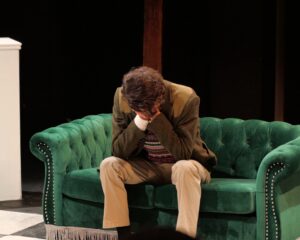On Thursday, Oct. 10, the New Writing Series (NWS) held the first bi-weekly reading of the semester featuring poets Sarah Green and Sara Nicholson. The poets’ performances demonstrated the NWS’ mission to find “new” writing and celebrate the innovative work materializing in the contemporary poetry world.
The NWS’ motto is “Making it New since 1999,” and their mission is to highlight the creative writers of our time by hosting readings at the University of Maine. The series further describes their message as “Conceived as an instrument for investigating the whole spectrum of possibilities for contemporary work in poetry, prose, translation, and the new media, the NWS puts an emphasis on innovative, adventurous, and/or unduly neglected writing.”
Thursday’s reading opened with English Department Chair and Professor Steve Evans, who is also the series coordinator, putting a spotlight on the storied history of the NWS and the fact that the Series celebrates its 20th year of readings this fall. Poetry professor Jennifer Moxley then introduced the two poets and aimed to describe the similarities as well as the individual characteristics of each poet reading. Moxley described her personal experience of reading Green and Nicholson’s work.
“The filmmaker Quentin Tarantino taught me the term ‘hangout movies.’ These are movies that, while they might not get as much attention as the big effects or obvious in-your-face blockbusters or popular favorites like Pulp Fiction, [they] are movies whose characters and in whose worlds you want to hang out,” Moxley explained. “In poetry too I think there are hangout books, books we return to over and over again because we like to hang out with the spirit that vibrates through their words … I recognized in the books last summer by our two readers … this quality of a hangout book for me. Returning to these books this fall that sense was confirmed. I liked the spirits I found vibrating through the words. I wanted to hang out with these poems.”
Both poets’ work highlighted an interesting sense of spatiality or inhabiting one’s world that each poet understood in unique ways. Sarah Green, reading first, offered an interesting description of one’s temporal existence in the poem “Skeleton Evenings” which she provides backstory for, detailing the occasionally meager and “roughing it” nature of going through graduate school.
“Just a few layers between my skeleton and this lottery ticket, / these shopping bags, these pears, this snow, these strangers / shoveling,” read Green. “My skeleton is unknown now to archaeologists / but has a weight and age they could test for.”
Green had an ability to capture one’s experience through context in her writing, placing one’s life among the objects and scenes around it, allowing us to understand the voice of the poem in relief to the physical poem-world.
Sara Nicholson read next. She read first from the title poem of her book “What the Lyric is.” This poem offered an interesting example of the contrast between the two poet’s work. It showed the unique poetic world that Nicholson’s work inhabits, filled with more references to nature (a common trope of lyric-style poetry), flowers, fruit, past writers as well as the contemporary world of social media, in addition to depictions of the female body and how people deal with weather occurrences. An excerpt from this poem that sees Nicholson at her most ponderous is as follows:
“I’ve been told / We should pretend / That everything we see is real, / That images should try / As best they can / To come to life. I feel that iron / Should take the place of snow / In the literature / And that silk flowers / Should be manufactured like / Real ones each spring.”
Nicholson’s poetry functions in a somewhat surreal manner and her work often depicts one’s attempt to grapple with a fierce or imposing natural world or environment. But the message of her work feels more positive than simple destruction — a way out of the strange forces of the world is often through acceptance or settling into one’s individual sphere. Her work, in part, explores the complex ways we inhabit nature, with powerful forces on both sides, as well as other ways that language and ideas hold strange power, like how she ends her poem “Don’t” with “Words / Are angels. Everything I say is true.”
Sarah Green’s book “Earth Science” can be found at: https://www.spdbooks.org/Products/9780990602033/earth-science.aspx
and Sara Nicholson’s book “What the Lyric is” can be found at:
https://www.spdbooks.org/Products/9780996778619/what-the-lyric-is.aspx









